Assessment of Greenhouse Gases and Pollutant Emissions in the Road Freight Transport Sector: A Case Study for São Paulo State, Brazil
Abstract
1. Introduction
2. Literature Review
3. Methodology
3.1. The Low Emissions Analysis Platform (Previously Called Long-Range Energy Alternatives Planning System) (LEAP)
3.2. Alternative Technologies for the Road Freight Sector
3.3. São Paulo State Energy System
3.4. Cost Analysis
3.5. Assumptions Common to all Scenarios
3.6. Alternative Options Scenarios
3.7. Sensitivity Analysis
4. Results
4.1. GHG Emissions
4.2. Local Air Pollutants
4.2.1. Carbon Monoxide (CO)
4.2.2. Hydrocarbons (HCs)
4.2.3. Nitrogen Oxides (NOx)
4.2.4. Particulate Matter (PM)
4.3. Sensitivity Analysis
4.4. Cost Analysis
5. Discussion
6. Conclusions
Author Contributions
Funding
Conflicts of Interest
Appendix A
| Years | EmDeg CO (%) | EmDeg HC (%) | EmDeg CH4 (%) | EmDeg Nox (%) | EmDeg MP (%) | EmDeg N2O (%) | EmDeg CO2 (%) | Surv MHDT |
|---|---|---|---|---|---|---|---|---|
| 0 | 100 | 100 | 100 | 100 | 100 | 100 | 100 | 100 |
| 1 | 100 | 100 | 100 | 100 | 100 | 100 | 100 | 97 |
| 2 | 109 | 102 | 100 | 104 | 92 | 100 | 96.61 | 94.80 |
| 3 | 532 | 731 | 100 | 313 | 574 | 100 | 108.65 | 92.10 |
| 4 | 489 | 820 | 100 | 319 | 572 | 100 | 108.65 | 89.50 |
| 5 | 561 | 662 | 100 | 321 | 593 | 100 | 108.65 | 86.80 |
| 6 | 563 | 752 | 100 | 319 | 636 | 100 | 108.65 | 84.10 |
| 7 | 667 | 1415 | 100 | 337 | 834 | 100 | 108.65 | 81.40 |
| 8 | 667 | 1415 | 100 | 337 | 834 | 100 | 108.65 | 78.70 |
| 9 | 567 | 1361 | 100 | 384 | 773 | 100 | 108.65 | 75.90 |
| 10 | 595 | 1802 | 100 | 458 | 969 | 100 | 108.65 | 73.10 |
| 11 | 1092 | 3233 | 100 | 469 | 2473 | 100 | 108.65 | 70.30 |
| 12 | 1215 | 3944 | 100 | 742 | 4973 | 100 | 108.65 | 67.50 |
| 13 | 1215 | 3944 | 100 | 742 | 4973 | 100 | 108.65 | 64.60 |
| 14 | 1215 | 3944 | 100 | 742 | 4973 | 100 | 108.65 | 61.80 |
| 15 | 1215 | 3944 | 100 | 742 | 4973 | 100 | 108.65 | 58.90 |
| 16 | 1215 | 3944 | 100 | 742 | 4973 | 100 | 108.65 | 56.10 |
| 17 | 1215 | 3944 | 100 | 742 | 4973 | 100 | 108.65 | 53.20 |
| 18 | 1215 | 3944 | 100 | 742 | 4973 | 100 | 108.65 | 50.40 |
| 19 | 1215 | 3944 | 100 | 742 | 4973 | 100 | 108.65 | 47.70 |
| 20 | 1215 | 3944 | 100 | 742 | 4973 | 100 | 108.65 | 45.00 |
| 21 | 1215 | 3944 | 100 | 742 | 4973 | 100 | 108.65 | 42.30 |
| 22 | 1215 | 3944 | 100 | 742 | 4973 | 100 | 108.65 | 39.70 |
| 23 | 1215 | 3944 | 100 | 742 | 4973 | 100 | 108.65 | 37.20 |
| 24 | 1215 | 3944 | 100 | 742 | 4973 | 100 | 108.65 | 34.80 |
| 25 | 1215 | 3944 | 100 | 742 | 4973 | 100 | 108.65 | 32.50 |
| 26 | 1215 | 3944 | 100 | 742 | 4973 | 100 | 108.65 | 30.20 |
| 27 | 1215 | 3944 | 100 | 742 | 4973 | 100 | 108.65 | 28.10 |
| 28 | 1215 | 3944 | 100 | 742 | 4973 | 100 | 108.65 | 26.10 |
| 29 | 1215 | 3944 | 100 | 742 | 4973 | 100 | 108.65 | 24.10 |
| 30 | 1215 | 3944 | 100 | 742 | 4973 | 100 | 108.65 | 22.30 |
| 31 | 1215 | 3944 | 100 | 742 | 4973 | 100 | 108.65 | 20.60 |
| 32 | 1215 | 3944 | 100 | 742 | 4973 | 100 | 108.65 | 19.00 |
| 33 | 1215 | 3944 | 100 | 742 | 4973 | 100 | 108.65 | 17.50 |
| 34 | 1215 | 3944 | 100 | 742 | 4973 | 100 | 108.65 | 16.00 |
| 35 | 1215 | 3944 | 100 | 742 | 4973 | 100 | 108.65 | 14.90 |
| 36 | 1215 | 3944 | 100 | 742 | 4973 | 100 | 108.65 | 13.70 |
| 37 | 1215 | 3944 | 100 | 742 | 4973 | 100 | 108.65 | 12.60 |
| 38 | 1215 | 3944 | 100 | 742 | 4973 | 100 | 108.65 | 11.60 |
| 39 | 1215 | 3944 | 100 | 742 | 4973 | 100 | 108.65 | 10.70 |
| 40 | 1215 | 3944 | 100 | 742 | 4973 | 100 | 108.65 | 9.90 |
| 41 | 1215 | 3944 | 100 | 742 | 4973 | 100 | 108.65 | 9.10 |
| 42 | 1215 | 3944 | 100 | 742 | 4973 | 100 | 108.65 | 8.40 |
| 43 | 1215 | 3944 | 100 | 742 | 4973 | 100 | 108.65 | 7.80 |
| 44 | 1215 | 3944 | 100 | 742 | 4973 | 100 | 108.65 | 7.20 |
| 45 | 1215 | 3944 | 100 | 742 | 4973 | 100 | 108.65 | 6.60 |
| 46 | 1215 | 3944 | 100 | 742 | 4973 | 100 | 108.65 | 6.10 |
| 47 | 1215 | 3944 | 100 | 742 | 4973 | 100 | 108.65 | 5.60 |
| 48 | 1215 | 3944 | 100 | 742 | 4973 | 100 | 108.65 | 5.20 |
| 49 | 1215 | 3944 | 100 | 742 | 4973 | 100 | 108.65 | 4.80 |
| 50 | 1215 | 3944 | 100 | 742 | 4973 | 100 | 108.65 | 4.40 |
| 51 | 1215 | 3944 | 100 | 742 | 4973 | 100 | 108.65 | 4.10 |
| 52 | 1215 | 3944 | 100 | 742 | 4973 | 100 | 108.65 | 3.70 |
| 53 | 1215 | 3944 | 100 | 742 | 4973 | 100 | 108.65 | 3.40 |
| 54 | 1215 | 3944 | 100 | 742 | 4973 | 100 | 108.65 | 3.20 |
| 55 | 1215 | 3944 | 100 | 742 | 4973 | 100 | 108.65 | 2.90 |
| 56 | 1215 | 3944 | 100 | 742 | 4973 | 100 | 108.65 | 2.60 |
| 57 | 1215 | 3944 | 100 | 742 | 4973 | 100 | 108.65 | 2.40 |
| 58 | 1215 | 3944 | 100 | 742 | 4973 | 100 | 108.65 | 2.10 |
| 59 | 1215 | 3944 | 100 | 742 | 4973 | 100 | 108.65 | 1.90 |
References
- Liu, X. Microbial technology for the sustainable development of energy and environment. Biotechnol. Reports 2020, 27, e00486. [Google Scholar] [CrossRef]
- Schlenzig, C. Energy planning and environmental management with the information and decision support system MESAP. Int. J. Glob. Energy Issues 1998, 12, 81–91. [Google Scholar] [CrossRef]
- Capros, P.; Mantzos, L. European Union post-Kyoto scenarios: Benefits from accelerated technology progress. Int. J. Glob. Energy Issues 2000, 14, 204–221. [Google Scholar] [CrossRef]
- McDowall, W.; Anandarajah, G.; Dodds, P.E.; Tomei, J. Implications of sustainability constraints on UK bioenergy development: Assessing optimistic and precautionary approaches with UK MARKAL. Energy Policy 2012, 47, 424–436. [Google Scholar] [CrossRef]
- Pöschl, M.; Ward, S.; Owende, P. Evaluation of energy efficiency of various biogas production and utilization pathways. Appl. Energy 2010, 87, 3305–3321. [Google Scholar] [CrossRef]
- Cooper, J.; Hawkes, A.; Balcombe, P. Life cycle environmental impacts of natural gas drivetrains used in UK road freighting and impacts to UK emission targets. Sci. Total Environ. 2019, 674, 482–493. [Google Scholar] [CrossRef]
- Jacobsson, S.; Lauber, V. The politics and policy of energy system transformation—Explaining the German diffusion of renewable energy technology. Energy Policy 2006, 34, 256–276. [Google Scholar] [CrossRef]
- Sadri, A.; Ardehali, M.M.M.; Amirnekooei, K. General procedure for long-term energy-environmental planning for transportation sector of developing countries with limited data based on LEAP (long-range energy alternative planning) and EnergyPLAN. Energy 2014, 77, 831–843. [Google Scholar] [CrossRef]
- Machado, P.G.; Mouette, D.; Villanueva, L.D.; Esparta, A.R.; Mendes Leite, B.; Moutinho dos Santos, E. Energy systems modeling: Trends in research publication. Wiley Interdiscip. Rev. Energy Environ. 2018, 8, 1–15. [Google Scholar] [CrossRef]
- Hong, S.; Chung, Y.; Kim, J.; Chun, D. Analysis on the level of contribution to the national greenhouse gas reduction target in Korean transportation sector using LEAP model. Renew. Sustain. Energy Rev. 2016, 60, 549–559. [Google Scholar] [CrossRef]
- Takeshita, T. Assessing the co-benefits of CO2 mitigation on air pollutants emissions from road vehicles. Appl. Energy 2012, 97, 225–237. [Google Scholar] [CrossRef]
- Song, S. Assessment of transport emissions impact and the associated social cost for Chengdu, China. Int. J. Sustain. Transp. 2018, 12, 128–139. [Google Scholar] [CrossRef]
- Brown, K.E.; Henze, D.K.; Milford, J.B. Accounting for climate and air quality damages in future U.S. electricity generation scenarios. Environ. Sci. Technol. 2013, 47, 3065–3072. [Google Scholar] [CrossRef] [PubMed]
- Fan, F.; Lei, Y.; Li, L. Health damage assessment of particulate matter pollution in Jing-Jin-Ji region of China. Environ. Sci. Pollut. Res. 2019, 26, 7883–7895. [Google Scholar] [CrossRef]
- Cunha-Lopes, I.; Martins, V.; Faria, T.; Correia, C.; Almeida, S.M. Children’s exposure to sized-fractioned particulate matter and black carbon in an urban environment. Build. Environ. 2019, 155, 187–194. [Google Scholar] [CrossRef]
- Lumbreras, J.; Valdés, M.; Borge, R.; Rodríguez, M.E. Assessment of vehicle emissions projections in Madrid (Spain) from 2004 to 2012 considering several control strategies. Transp. Res. Part A Policy Pract. 2008, 42, 646–658. [Google Scholar] [CrossRef][Green Version]
- Proost, S.; Van Regemorter, D.; Lantz, F.; Saint-Antonin, V. Limiting air pollution from transport: Economic evaluation of policy options for the European Union. Int. J. Glob. Energy Issues 2000, 14, 320–330. [Google Scholar] [CrossRef]
- Shabbir, R.; Ahmad, S.S. Monitoring urban transport air pollution and energy demand in Rawalpindi and Islamabad using leap model. Energy 2010, 35, 2323–2332. [Google Scholar] [CrossRef]
- Skytte, K.; Pizarro, A.; Karlsson, K.B. Use of electric vehicles or hydrogen in the Danish transport sector in 2050? Wiley Interdiscip. Rev. Energy Environ. 2017, 6, e233. [Google Scholar] [CrossRef]
- Quiros, D.C.; Smith, J.; Thiruvengadam, A.; Huai, T.; Hu, S. Greenhouse gas emissions from heavy-duty natural gas, hybrid, and conventional diesel on-road trucks during freight transport. Atmos. Environ. 2017, 168, 36–45. [Google Scholar] [CrossRef]
- Karkatsoulis, P.; Siskos, P.; Paroussos, L.; Capros, P. Simulating deep CO2 emission reduction in transport in a general equilibrium framework: The GEM-E3T model. Transp. Res. Part D Transp. Environ. 2017, 55, 343–358. [Google Scholar] [CrossRef]
- Mcmichael, A.J.; Campbell-Lendrum, D.H.; Corvalán, C.F.; Ebi, K.L.; Githeko, A.K.; Scheraga, J.D.; Woodward, A. Climate Change and Human Health: Risks and Responses; World Health Organization (WHO): Geneva, Switzerland, 2003. [Google Scholar]
- Ur Rehman, S.A.; Cai, Y.; Fazal, R.; Das Walasai, G.; Mirjat, N.H. An integrated modeling approach for forecasting long-term energy demand in Pakistan. Energies 2017, 10, 1868. [Google Scholar] [CrossRef]
- Wu, Q.; Peng, C. Scenario analysis of carbon emissions of China’s electric power industry up to 2030. Energies 2016, 9, 988. [Google Scholar] [CrossRef]
- de Almeida Collaço, F.M.; Simoes, S.G.; Dias, L.P.; Duic, N.; Seixas, J.; Bermann, C. The dawn of urban energy planning – Synergies between energy and urban planning for São Paulo (Brazil) megacity. J. Clean. Prod. 2019, 215, 458–479. [Google Scholar] [CrossRef]
- Zhang, L.; Feng, Y.; Chen, B. Alternative scenarios for the development of a low-carbon city: A case study of Beijing, China. Energies 2011, 4, 2295–2310. [Google Scholar] [CrossRef]
- Flores, W.C.; Bustamante, B.; Pino, H.N.; Al-Sumaiti, A.; Rivera, S. A national strategy proposal for improved cooking stove adoption in Honduras: Energy consumption and cost-benefit analysis. Energies 2020, 13, 921. [Google Scholar] [CrossRef]
- Nieves, J.A.; Aristizábal, A.J.; Dyner, I.; Báez, O.; Ospina, D.H. Energy demand and greenhouse gas emissions analysis in Colombia: A LEAP model application. Energy 2019, 169, 380–397. [Google Scholar] [CrossRef]
- Hu, G.; Ma, X.; Ji, J. Scenarios and policies for sustainable urban energy development based on LEAP model – A case study of a postindustrial city: Shenzhen China. Appl. Energy 2019, 238, 876–886. [Google Scholar] [CrossRef]
- Emodi, N.V.; Emodi, C.C.; Murthy, G.P.; Emodi, A.S.A. Energy policy for low carbon development in Nigeria: A LEAP model application. Renew. Sustain. Energy Rev. 2017, 68, 247–261. [Google Scholar] [CrossRef]
- Alamia, A.; Magnusson, I.; Johnsson, F.; Thunman, H. Well-to-wheel analysis of bio-methane via gasification, in heavy duty engines within the transport sector of the European Union. Appl. Energy 2016, 170, 445–454. [Google Scholar] [CrossRef]
- Bai, A.; Jobbágy, P.; Popp, J.; Farkas, F.; Grasselli, G.; Szendrei, J.; Balogh, P. Technical and environmental effects of biodiesel use in local public transport. Transp. Res. Part D Transp. Environ. 2016, 47, 323–335. [Google Scholar] [CrossRef]
- Ferreira, M.B.; Salvador, R.; Barros, M.V.; de Souza, J.T.; Rabelo, T.G.L.; de Francisco, A.C.; Coelho, R.; Piekarski, C.M. Eco-efficiency of the differential ratio change in a heavy-duty vehicle and implications for the automotive industry. Sustain. Prod. Consum. 2020, 21, 145–155. [Google Scholar] [CrossRef]
- Askin, A.C.; Barter, G.E.; West, T.H.; Manley, D.K. The heavy-duty vehicle future in the United States: A parametric analysis of technology and policy tradeoffs. Energy Policy 2015, 81, 1–13. [Google Scholar] [CrossRef]
- Liimatainen, H.; van Vliet, O.; Aplyn, D. The potential of electric trucks – An international commodity-level analysis. Appl. Energy 2019, 236, 804–814. [Google Scholar] [CrossRef]
- Sen, B.; Ercan, T.; Tatari, O. Does a battery-electric truck make a difference? – Life cycle emissions, costs, and externality analysis of alternative fuel-powered Class 8 heavy-duty trucks in the United States. J. Clean. Prod. 2017, 141, 110–121. [Google Scholar] [CrossRef]
- Gao, Z.; LaClair, T.J.; Smith, D.E.; Daw, C.S. Exploring fuel-saving potential of long-haul truck hybridization. Transp. Res. Rec. 2015, 2502, 99–107. [Google Scholar] [CrossRef]
- Liu, X.; Yu, X. Enhancement of Butanol Production: From Biocatalysis to Bioelectrocatalysis. ACS Energy Lett. 2020, 5, 867–878. [Google Scholar] [CrossRef]
- Onarheim, K.; Hannula, I.; Solantausta, Y. Hydrogen enhanced biofuels for transport via fast pyrolysis of biomass: A conceptual assessment. Energy 2020, 199, 117337. [Google Scholar] [CrossRef]
- Neuwahl, F.; Löschel, A.; Mongelli, I.; Delgado, L. Employment impacts of EU biofuels policy: Combining bottom-up technology information and sectoral market simulations in an input-output framework. Ecol. Econ. 2008, 68, 447–460. [Google Scholar] [CrossRef]
- Gerboni, R.; Grosso, D.; Carpignano, A.; Dalla Chiara, B. Linking energy and transport models to support policy making. Energy Policy 2017, 111, 336–345. [Google Scholar] [CrossRef]
- Chollacoop, N.; Saisirirat, P.; Fukuda, T.; Fukuda, A. Scenario analyses of road transport energy demand: A case study of ethanol as a diesel substitute in Thailand. Energies 2011, 4, 108–125. [Google Scholar] [CrossRef]
- de Almeida Collaço, F.M.; Dias, L.P.; Simoes, S.G.; Pukšec, T.; Seixas, J.; Bermann, C. What if São Paulo (Brazil) would like to become a renewable and endogenous energy -based megacity? Renew. Energy 2019, 138, 416–433. [Google Scholar] [CrossRef]
- Costa, E.; Seixas, J.; Costa, G.; Turrentine, T. Interplay between ethanol and electric vehicles as low carbon mobility options for passengers in the municipality of São Paulo. Int. J. Sustain. Transp. 2017, 11, 518–525. [Google Scholar] [CrossRef]
- Dias, M.V.X.; Haddad, J.; Horta Nogueira, L.; da Costa Bortoni, E.; Passos da Cruz, R.A.; Akira Yamachita, R.; Goncalves, J.L. The impact on electricity demand and emissions due to the introduction of electric cars in the São Paulo power system. Energy Policy 2014, 65, 298–304. [Google Scholar] [CrossRef]
- Heaps, C.G. Long-Range Energy Alternatives Planning (LEAP) System; Stockholm Environment Institute: Somerville, MA, USA, 2006. [Google Scholar]
- Bhattacharyya, S.C.; Timilsina, G.R. A review of energy system models. Int. J. Energy Sect. Manag. 2010, 4, 494–518. [Google Scholar] [CrossRef]
- Heaps, C. LEAP Data Requirements for Energy Planning and Mitigation Assessment. Available online: http://www.energycommunity.org/documents/DataRequirements.pdf (accessed on 15 March 2019).
- Ministério da Ciência Tecnologia e Inovações. Opções Transversais para Mitigação de Emissões de Gases de Efeito Estufa: Captura, Transporte e Armazenamento de Carbono; Rathmann, R., Ed.; Ministério da Ciência Tecnologia e Inovações: Brasilia, Brazil, 2017.
- Lee, D.-Y.; Elgowainy, A.; Kotz, A.; Vijayagopal, R.; Marcinkoski, J. Life-cycle implications of hydrogen fuel cell electric vehicle technology for medium- and heavy-duty trucks. J. Power Sources 2018, 393, 217–229. [Google Scholar] [CrossRef]
- Susmozas, A.; Iribarren, D.; Zapp, P.; Linβen, J.; Dufour, J. Life-cycle performance of hydrogen production via indirect biomass gasification with CO2 capture. Int. J. Hydrogen Energy 2016, 41, 19484–19491. [Google Scholar] [CrossRef]
- Dufour, J.; Serrano, D.P.; Gálvez, J.L.; Moreno, J.; García, C. Life cycle assessment of processes for hydrogen production. Environmental feasibility and reduction of greenhouse gases emissions. Int. J. Hydrogen Energy 2009, 34, 1370–1376. [Google Scholar] [CrossRef]
- Balcombe, P.; Anderson, K.; Speirs, J.; Brandon, N.; Hawkes, A. Methane and CO2 Emissions From the Natural Gas Supply Chain an Evidence Assessment. Available online: www.sustainablegasinstitute.org (accessed on 12 May 2020).
- Ipeadata. PIB Estadual. Available online: http://www.ipeadata.gov.br/Default.aspx (accessed on 22 February 2017).
- Ipeadata. PIB Estadual per Capita. Available online: http://www.ipeadata.gov.br/Default.aspx (accessed on 22 February 2017).
- ANP. Anuário Estatístico Brasileiro do Petróleo, Gás Nnatural e Biocombustíveis. Available online: http://www.anp.gov.br/publicacoes/anuario-estatistico (accessed on 9 April 2020).
- SEEMSP. Balanço Energético do Estado de São Paulo 2017: Ano Base 2016. Available online: http://dadosenergeticos.energia.sp.gov.br/portalcev2/intranet/BiblioVirtual/diversos/BalancoEnergetico.pdf (accessed on 22 April 2019).
- CETESB. Emissões Veiculares no Estado de São Paulo 2014. Available online: https://cetesb.sp.gov.br/veicular/relatorios-e-publicacoes/ (accessed on 5 December 2018).
- SEEMSP. Dados Gás, Petróleo e Derivados. Available online: https://www.infraestruturameioambiente.sp.gov.br/infraestrutura/coordenadorias/coordenadoria-de-petroleo-gas-e-mineracao/dados-do-setor-de-petroleo-e-gas/ (accessed on 22 April 2019).
- ANEEL. BIG—Banco de Informações de Geração. Available online: https://www2.aneel.gov.br/aplicacoes/capacidadebrasil/Combustivel.cfm (accessed on 9 April 2020).
- de Villiers, M.G.; Kenny, A.R.; Howells, M.I. Sustainable Energy for South Africa: LEAP Data; Energy Research Institute: London, UK, 1999. [Google Scholar]
- de Villiers, M.G. Greenhouse Gas Baseline and Mitigation Options for the Commercial Sector; Energy Research Institute: London, UK, 1999. [Google Scholar]
- Souza, S.P. de Avaliação de Aspectos Econômicos e Ambientais da Produção Integrada de Etanol e Biodiesel. Available online: http://repositorio.unicamp.br/jspui/handle/REPOSIP/265819 (accessed on 26 August 2018).
- Sharma, A.; Strezov, V. Life cycle environmental and economic impact assessment of alternative transport fuels and power-train technologies. Energy 2017, 133, 1132–1141. [Google Scholar] [CrossRef]
- Intergovernmental Panel on Climate Change—IPCC. Revised 1996 IPCC Guidelines for National Greenhouse Gas Inventories. Volume 3: Reference Manual. 2020. Available online: https://www.ipcc-nggip.iges.or.jp/public/gl/invs1.html (accessed on 9 April 2019).
- EPE. Plano Decenal de Expansão de Energia 2029. Available online: https://www.epe.gov.br/pt/publicacoes-dados-abertos/publicacoes/plano-decenal-de-expansao-de-energia-2029 (accessed on 27 April 2020).
- EPE. Sistema de Informações Geográficas do Setor Energético Brasileiro. Available online: https://gisepe.epe.gov.br/WebMapEPE/ (accessed on 9 April 2020).
- SEEMSP. Matriz Energética do Estado de São Paulo 2035. Available online: https://cetesb.sp.gov.br/proclima/2011/03/09/matriz-energetica-do-estado-de-sao-paulo-2035/ (accessed on 4 June 2020).
- Brasil. Modelagem Setorial de Opções de Baixo Carbono para o Setor de Transportes. Available online: https://www.mctic.gov.br/mctic/opencms/ciencia/SEPED/clima/opcoes_mitigacao/Opcoes_de_Mitigacao_de_Emissoes_de_Gases_de_Efeito_Estufa_GEE_em_SetoresChave_do_Brasil.html (accessed on 20 October 2019).
- Brasil. Projeto de Lei do Senado n° 304, de 2017. Available online: https://www25.senado.leg.br/web/atividade/materias/-/materia/130612 (accessed on 4 June 2020).
- Mackay, D.J.C. Introduction to Monte Carlo Methods. In Learning in Graphical Models; Springer Netherlands: Dordrecht, The Netherlands, 1998; pp. 175–204. ISBN 0-262-60032-3. [Google Scholar]
- Tong, F.; Jaramillo, P.; Azevedo, I.M.L. Comparison of Life Cycle Greenhouse Gases from Natural Gas Pathways for Medium and Heavy-Duty Vehicles. Environ. Sci. Technol. 2015, 49, 7123–7133. [Google Scholar] [CrossRef]
- Çelebi, K.; Uludamar, E.; Tosun, E.; Yıldızhan, Ş.; Aydın, K.; Özcanlı, M. Experimental and artificial neural network approach of noise and vibration characteristic of an unmodified diesel engine fuelled with conventional diesel, and biodiesel blends with natural gas addition. Fuel 2017, 197, 159–173. [Google Scholar] [CrossRef]
- Baltacioglu, M.K.; Arat, H.T.; Özcanli, M.; Aydin, K. Experimental comparison of pure hydrogen and HHO (hydroxy) enriched biodiesel (B10) fuel in a commercial diesel engine. Int. J. Hydrogen Energy 2016, 41, 8347–8353. [Google Scholar] [CrossRef]
- Ogunkoya, D.; Fang, T. Engine performance, combustion, and emissions study of biomass to liquid fuel in a compression-ignition engine. Energy Convers. Manag. 2015, 95, 342–351. [Google Scholar] [CrossRef]
- Adam, A.; Ramlan, N.A.; Jaharudin, N.F.; Hamzah, H.; Othman, M.F.; Mrwan, A.A.G. Analysis of combustion characteristics, engine performance and exhaust emissions of diesel engine fueled with upgraded waste source fuel. Int. J. Hydrogen Energy 2017, 42, 17993–18004. [Google Scholar] [CrossRef]
- MMA. Poluentes Atmosféricos. Available online: https://www.mma.gov.br/cidades-sustentaveis/qualidade-do-ar/poluentes-atmosféricos.html#Dioxido_de_nitrogenio (accessed on 15 August 2019).
- Emiroğlu, A.O.; Şen, M. Combustion, performance and exhaust emission characterizations of a diesel engine operating with a ternary blend (alcohol-biodiesel-diesel fuel). Appl. Therm. Eng. 2018, 133, 371–380. [Google Scholar] [CrossRef]
- Hoekman, S.K.; Robbins, C. Review of the effects of biodiesel on NOx emissions. Fuel Process. Technol. 2012, 96, 237–249. [Google Scholar] [CrossRef]
- Qasim, M.; Ansari, T.M.; Hussain, M. Combustion, performance, and emission evaluation of a diesel engine with biodiesel like fuel blends derived from a mixture of Pakistani waste canola and waste transformer oils. Energies 2017, 10, 1023. [Google Scholar] [CrossRef]
- Liu, J.; Wang, H.; Li, Y.; Zheng, Z.; Xue, Z.; Shang, H.; Yao, M. Effects of diesel/PODE (polyoxymethylene dimethyl ethers) blends on combustion and emission characteristics in a heavy duty diesel engine. Fuel 2016, 177, 206–216. [Google Scholar] [CrossRef]
- Hosseini, S.M.; Ahmadi, R. Performance and emissions characteristics in the combustion of co-fuel diesel-hydrogen in a heavy duty engine. Appl. Energy 2017, 205, 911–925. [Google Scholar] [CrossRef]
- Singh, D.; Singal, S.K.; Garg, M.O.; Maiti, P.; Mishra, S.; Ghosh, P.K. Transient performance and emission characteristics of a heavy-duty diesel engine fuelled with microalga Chlorella variabilis and Jatropha curcas biodiesels. Energy Convers. Manag. 2015, 106, 892–900. [Google Scholar] [CrossRef]
- Pan, W.; Yao, C.; Han, G.; Wei, H.; Wang, Q. The impact of intake air temperature on performance and exhaust emissions of a diesel methanol dual fuel engine. Fuel 2015, 162, 101–110. [Google Scholar] [CrossRef]
- Vermeulen, R.; Verbeek, R.; van Goethem, S.; Smokers, R. Emissions Testing of two Euro VI LNG Heavy-Duty Vehicles in the Netherlands: Tank-to-Wheel Emissions. Available online: https://publications.tno.nl/publication/34625802/QoDRSe/TNO-2017-R11336.pdf (accessed on 12 August 2018).
- Grigoratos, T.; Fontaras, G.; Martini, G.; Peletto, C. A study of regulated and green house gas emissions from a prototype heavy-duty compressed natural gas engine under transient and real life conditions. Energy 2016, 103, 340–355. [Google Scholar] [CrossRef]
- Yuan, J.H.; Zhou, S.; Peng, T.D.; Wang, G.H.; Ou, X.M. Petroleum substitution, greenhouse gas emissions reduction and environmental benefits from the development of natural gas vehicles in China. Pet. Sci. 2018, 15, 644–656. [Google Scholar] [CrossRef]
- Heywood, J.B. Internal Combustion Engine: Fundamentals, 2nd ed.; McGraw-Hill Education: New York, NY, USA, 2018. [Google Scholar]
- Sathiyamoorthi, R.; Sankaranarayanan, G.; Adhith kumaar, S.B.; Chiranjeevi, T.; Dilip Kumar, D. Experimental investigation on performance, combustion and emission characteristics of a single cylinder diesel engine fuelled by biodiesel derived from Cymbopogon Martinii. Renew. Energy 2019, 132, 394–415. [Google Scholar] [CrossRef]
- Nantha Gopal, K.; Ashok, B.; Senthil Kumar, K.; Thundil Karuppa Raj, R.; Denis Ashok, S.; Varatharajan, V.; Anand, V. Performance analysis and emissions profile of cottonseed oil biodiesel–ethanol blends in a CI engine. Biofuels 2018, 9, 711–718. [Google Scholar] [CrossRef]
- Al-lwayzy, S.H.; Yusaf, T. Diesel engine performance and exhaust gas emissions using Microalgae Chlorella protothecoides biodiesel. Renew. Energy 2017, 101, 690–701. [Google Scholar] [CrossRef]
- CETESB. Poluentes—Qualidade do Ar. Available online: https://cetesb.sp.gov.br/ar/poluentes/ (accessed on 15 August 2019).
- Dapper, S.N.; Spohr, C.; Zanini, R.R. Poluição do ar como fator de risco para a saúde: Uma revisão sistemática no estado de São Paulo. Estud. AVANÇADOS 2016, 30, 83–97. [Google Scholar] [CrossRef]
- Teixeira, A.C.R.; Borges, R.R.; Machado, P.G.; Mouette, D.; Dutra Ribeiro, F.N. PM emissions from heavy-duty trucks and their impacts on human health. Atmos. Environ. 2020, 241, 117814. [Google Scholar] [CrossRef]
- Hora, T.S.; Agarwal, A.K. Experimental study of the composition of hydrogen enriched compressed natural gas on engine performance, combustion and emission characteristics. Fuel 2015, 160, 470–478. [Google Scholar] [CrossRef]
- Park, C.W.; Kim, C.G.; Choi, Y.; Lee, S.Y.; Lee, S.W.; Yi, U.H.; Lee, J.H.; Kim, T.M.; Kim, D.S. development of hydrogen-compressed natural gas blend engine for heavy duty vehicles. Int. J. Automot. Technol. 2017, 18, 1061–1066. [Google Scholar] [CrossRef]
- Lajevardi, S.M.; Axsen, J.; Crawford, C. Examining the role of natural gas and advanced vehicle technologies in mitigating CO2 emissions of heavy-duty trucks: Modeling prototypical British Columbia routes with road grades. Transp. Res. Part D Transp. Environ. 2018, 62, 186–211. [Google Scholar] [CrossRef]
- Tu, J.; Yang, C. Key Factors Influencing Consumers’ Purchase of Electric Vehicles. Sustainability 2019, 11, 3863. [Google Scholar] [CrossRef]
- Yang, Y.; Tan, Z. Investigating the Influence of Consumer Behavior and Governmental Policy on the Diffusion of Electric Vehicles in Beijing, China. Sustainability 2019, 11, 6967. [Google Scholar] [CrossRef]
- Dias, J.L.D.M.; Quaglino, M.A. A questão do petróleo no Brasil: Uma história da Petrobrás; Fundação Getúlio Vargas: Rio de Janeiro, Brazil, 1993. [Google Scholar]
- Barat, J. A evolução dos transportes no Brasil; IBGE: Rio de janeiro, Brazil, 1978.
- Moreira, J.R.; Goldemberg, J. The alcohol program. Energy Policy 1999, 27, 229–245. [Google Scholar] [CrossRef]
- EPE; BEN—Séries Históricas Completas. Available online: http://www.epe.gov.br/pt/publicacoes-dados-abertos/publicacoes/BEN-Series-Historicas-Completas (accessed on 18 October 2019).
- MME. Síntese RenovaBio. Available online: http://www.mme.gov.br/documents/10584/135676503/RENOVABIO_breve+resumo.pdf/4cc8ffe5-c517-45db-adc4-a81acd138384 (accessed on 3 July 2019).
- Laldjebaev, M.; Morreale, S.J.; Sovacool, B.K.; Kassam, K.A.S. Rethinking energy security and services in practice: National vulnerability and three energy pathways in Tajikistan. Energy Policy 2018, 114, 39–50. [Google Scholar] [CrossRef]
- Bluszcz, A. European economies in terms of energy dependence. Qual. Quant. 2016, 51. [Google Scholar] [CrossRef]
- Bompard, E.; Carpignano, A.; Erriquez, M.; Grosso, D.; Pession, M.; Profumo, F. National energy security assessment in a geopolitical perspective. Energy 2017, 130, 144–154. [Google Scholar] [CrossRef]
- MDIC. Rota 2030—Mobilidade e Logística. Available online: http://www.mdic.gov.br/index.php/competitividade-industrial/setor-automotivo/rota2030 (accessed on 16 July 2019).
- Schulte, J.; Ny, H. Electric road systems: Strategic stepping stone on the way towards sustainable freight transport? Sustain. 2018, 10, 1148. [Google Scholar] [CrossRef]
- Zhao, Y.; Onat, N.C.; Kucukvar, M.; Tatari, O. Carbon and energy footprints of electric delivery trucks: A hybrid multi-regional input-output life cycle assessment. Transp. Res. Part D Transp. Environ. 2016, 47, 195–207. [Google Scholar] [CrossRef]
- Azevedo Filho, E.T.; Palma, M.A.M.; Perestrelo, M.; da Hora, H.R.M.; Lira, R.A. The pre-salt layer and challenges to competitiveness in Brazil: Critical reflections on the local content policy in the oil and gas Sector. Extr. Ind. Soc. 2019, 6, 1168–1173. [Google Scholar] [CrossRef]

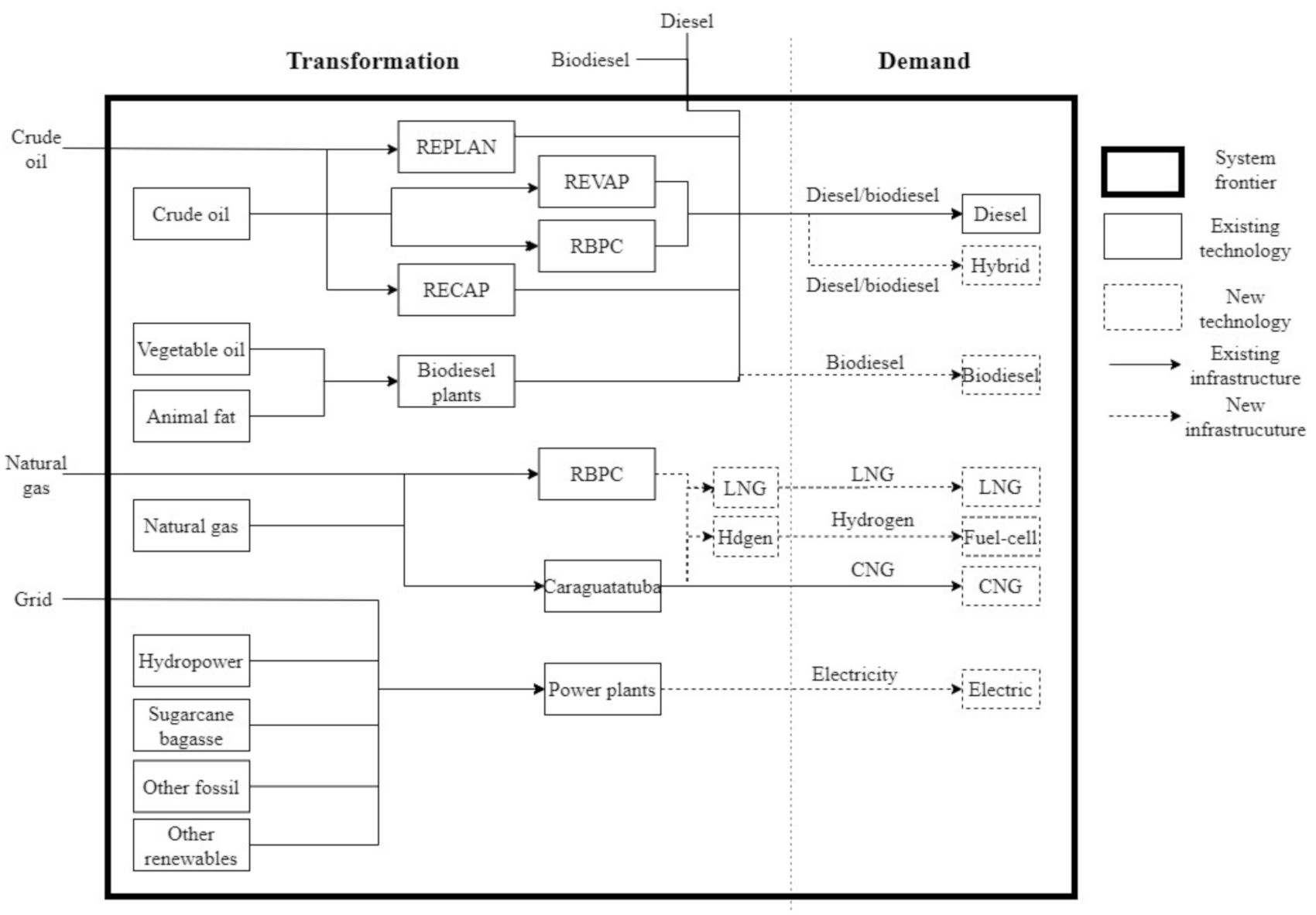
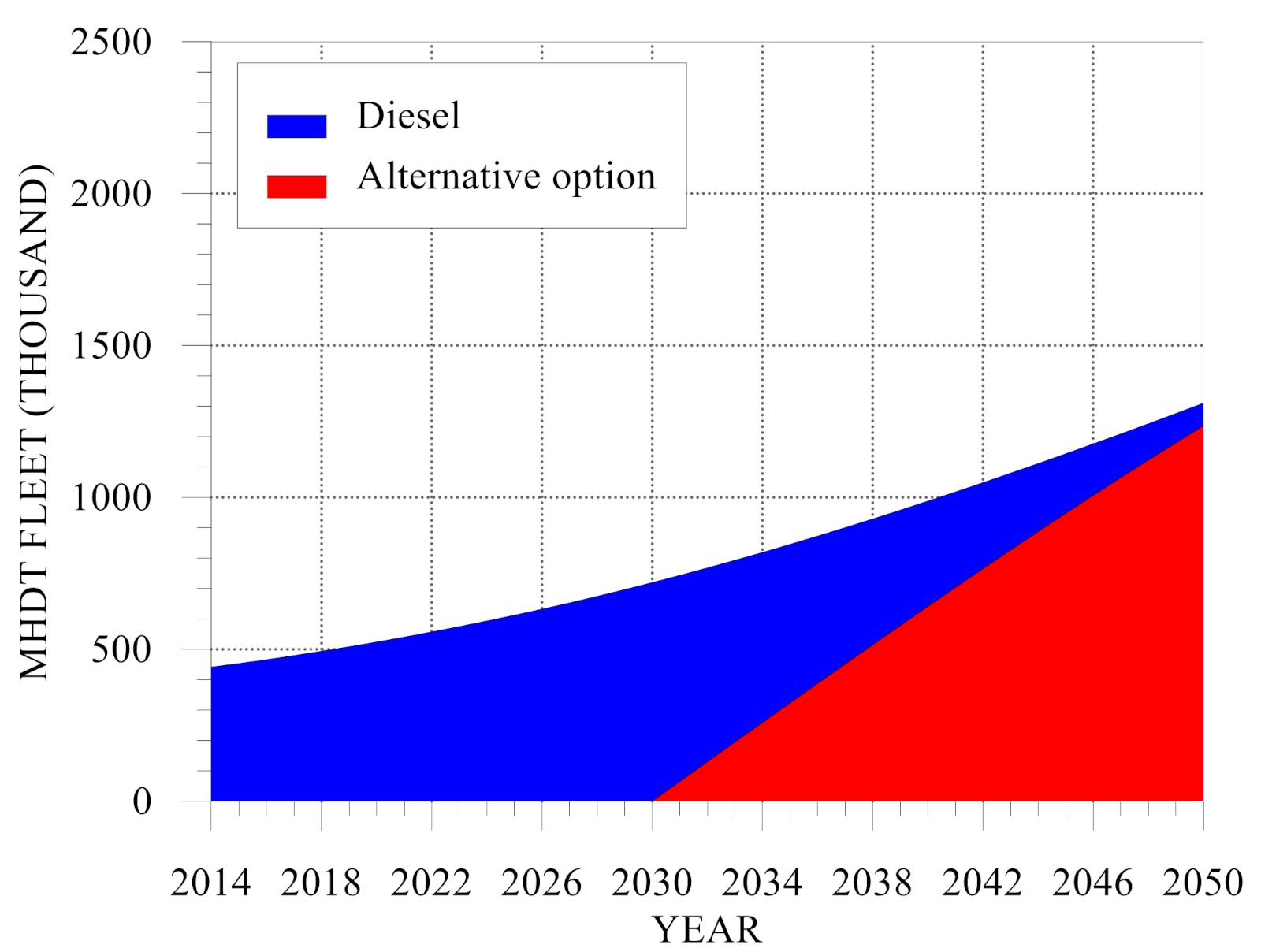
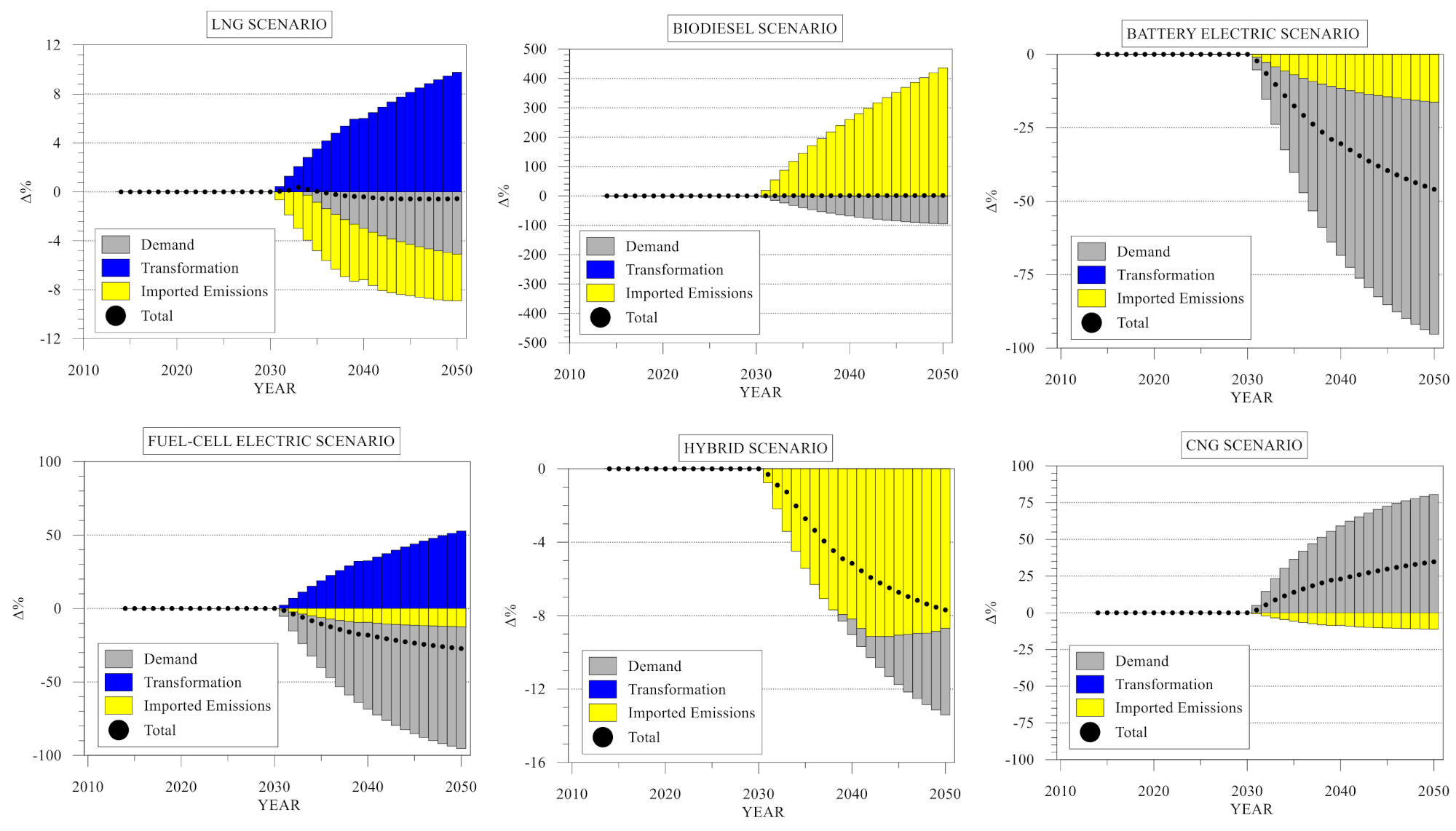
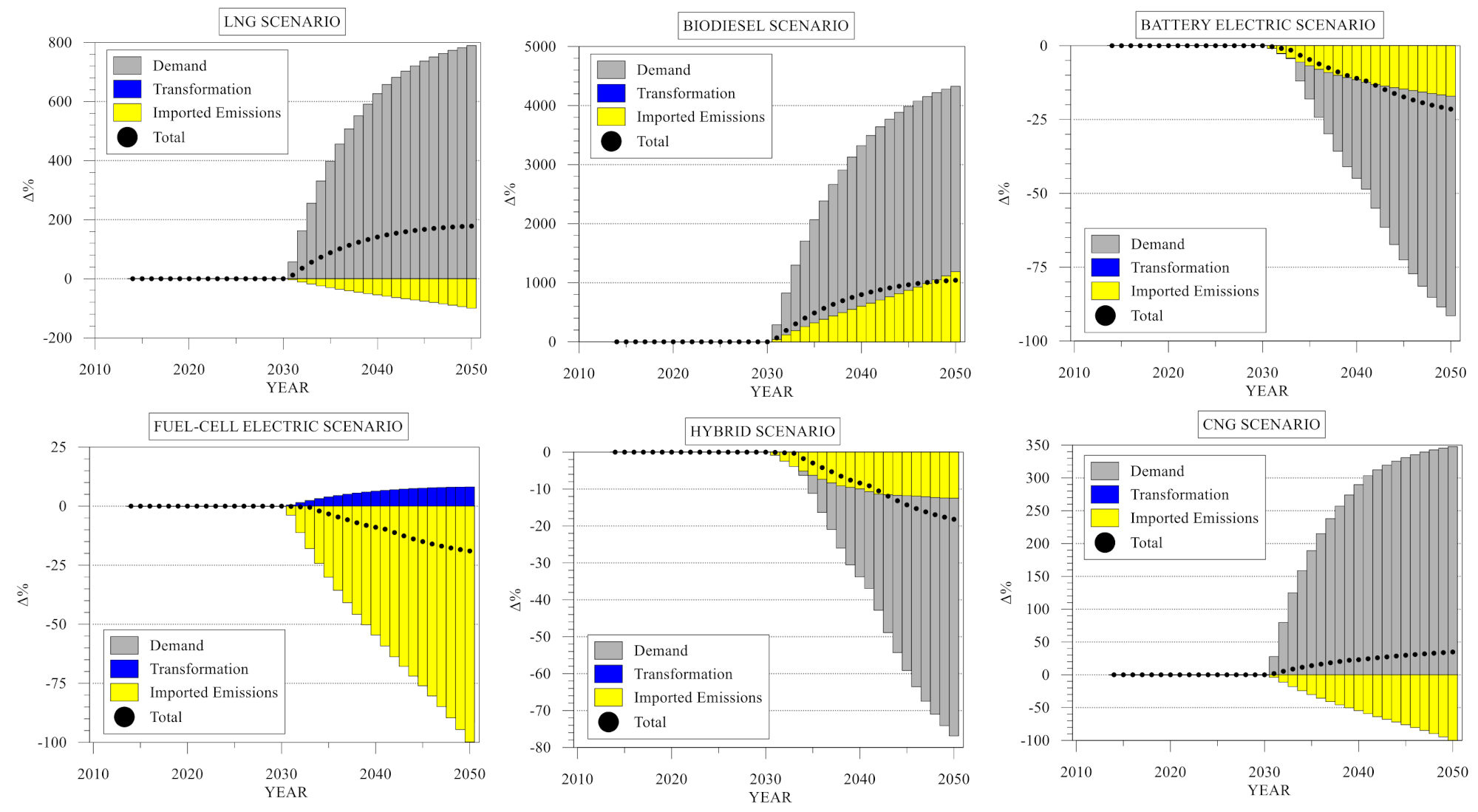
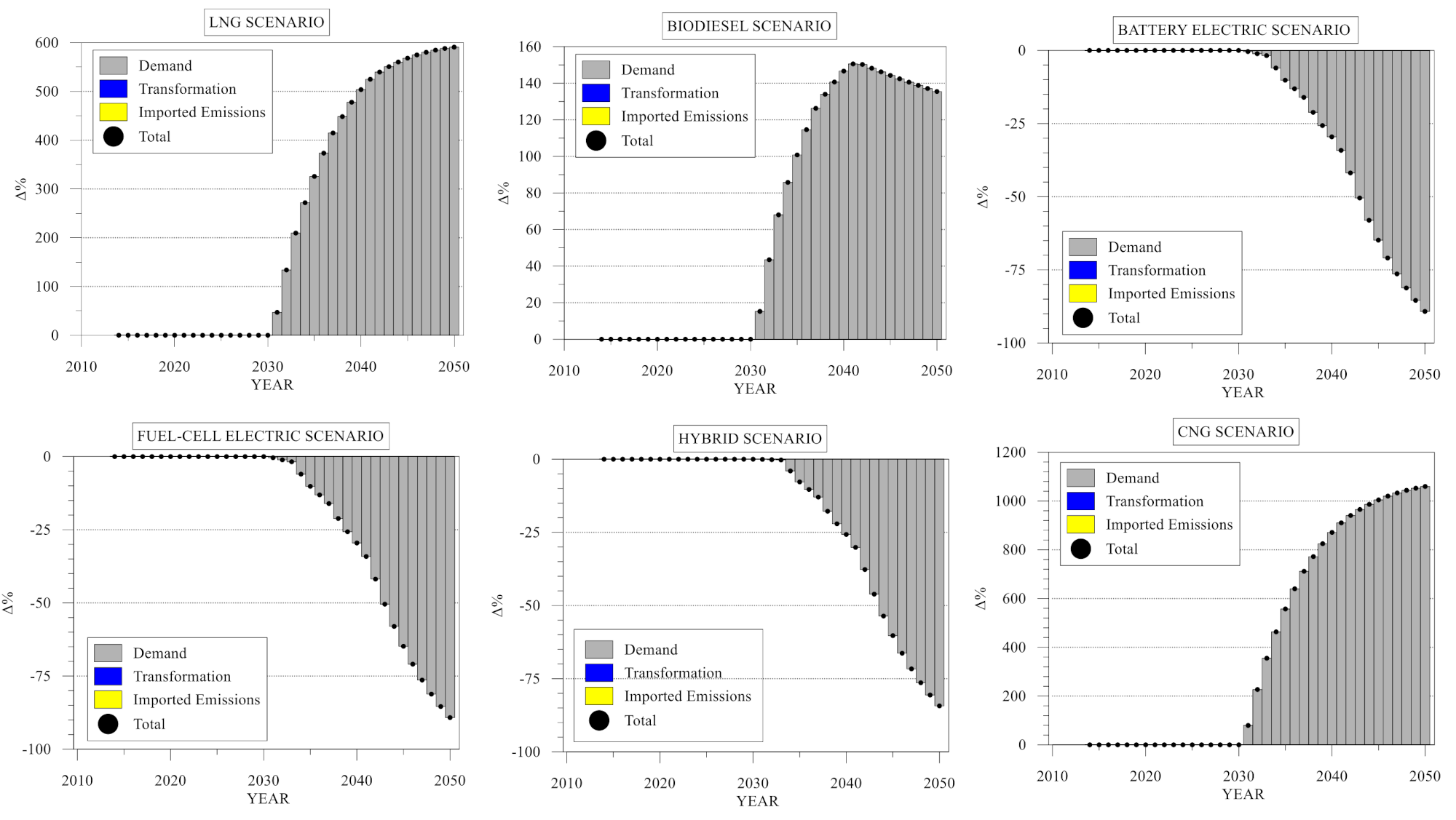
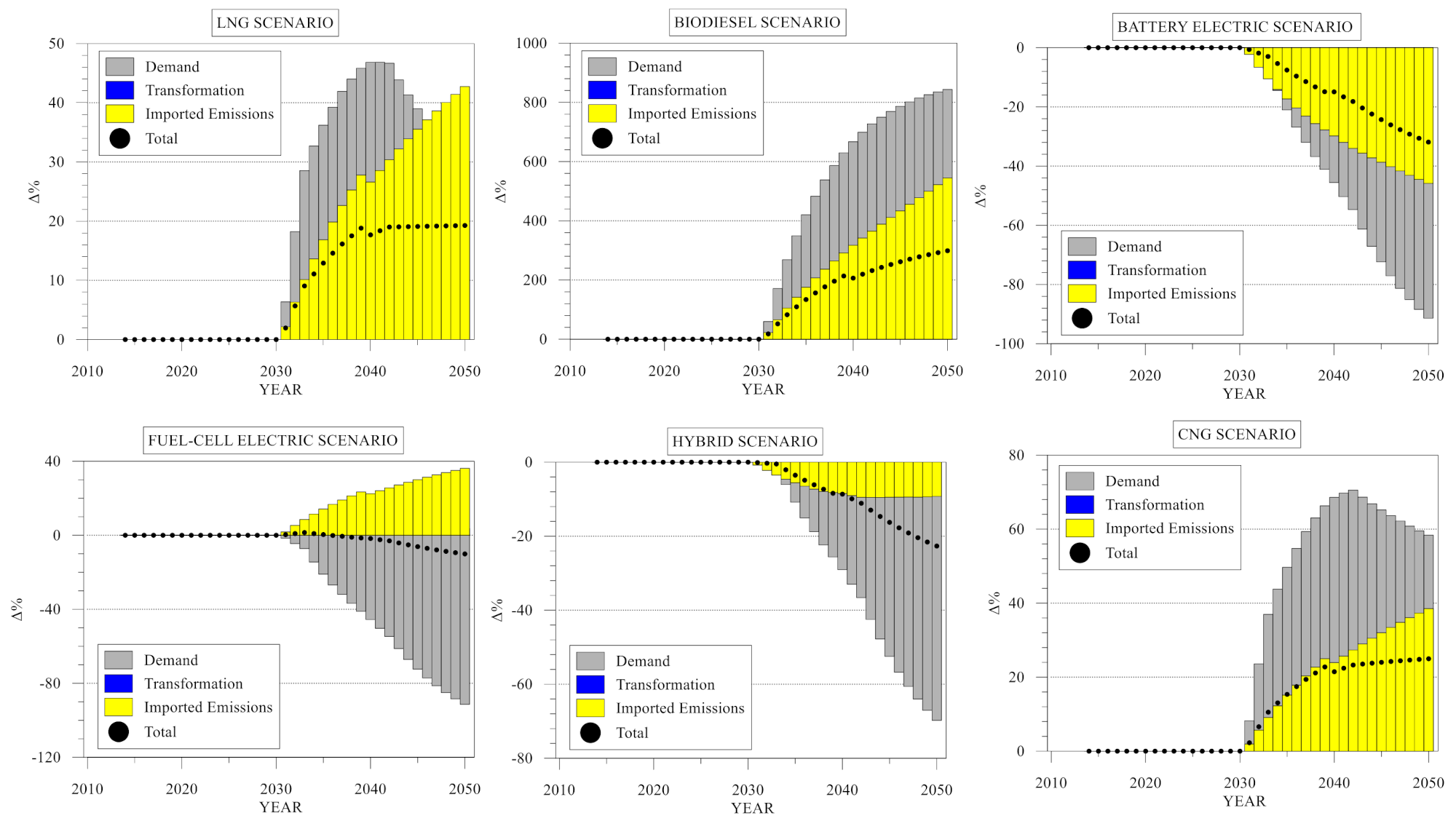
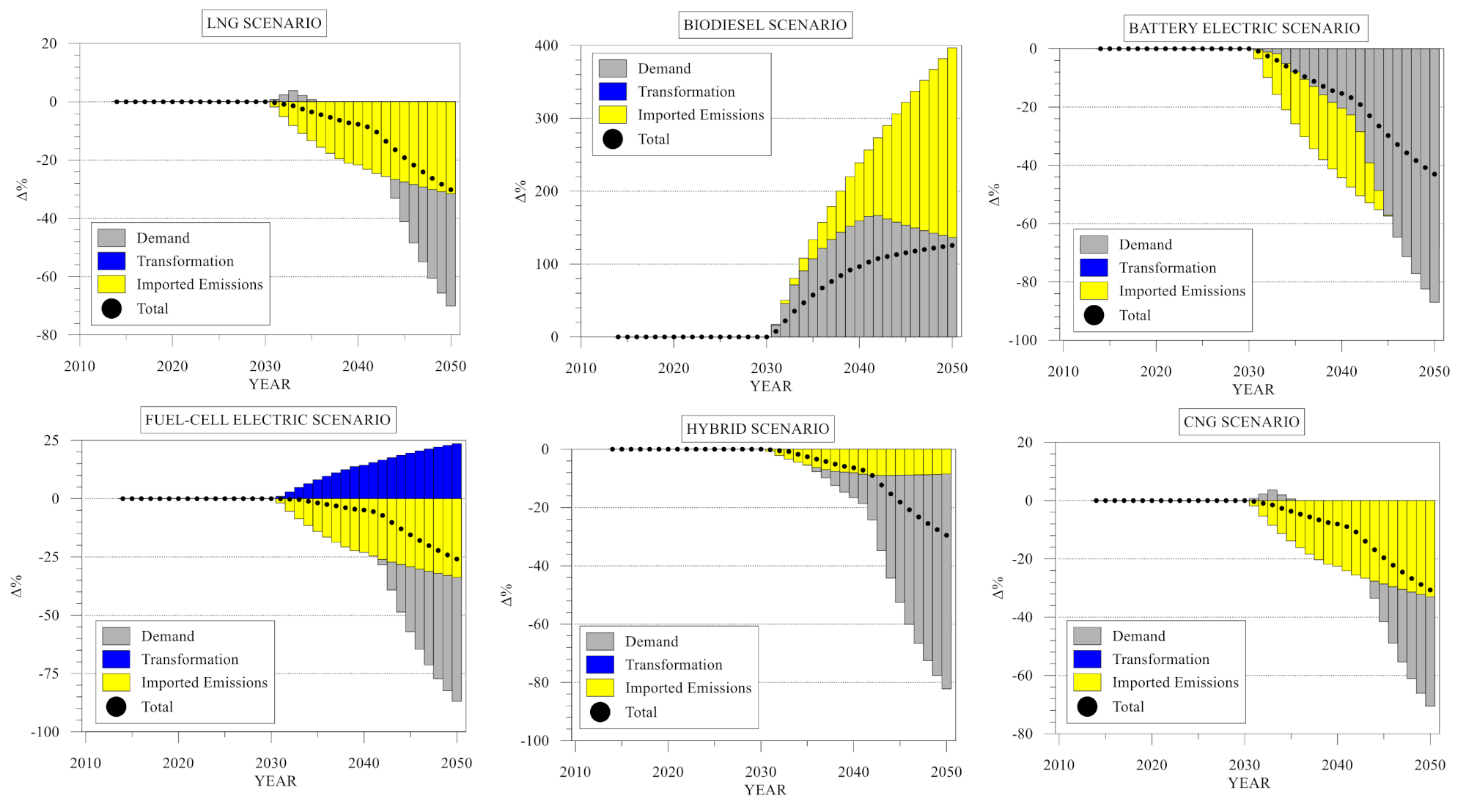
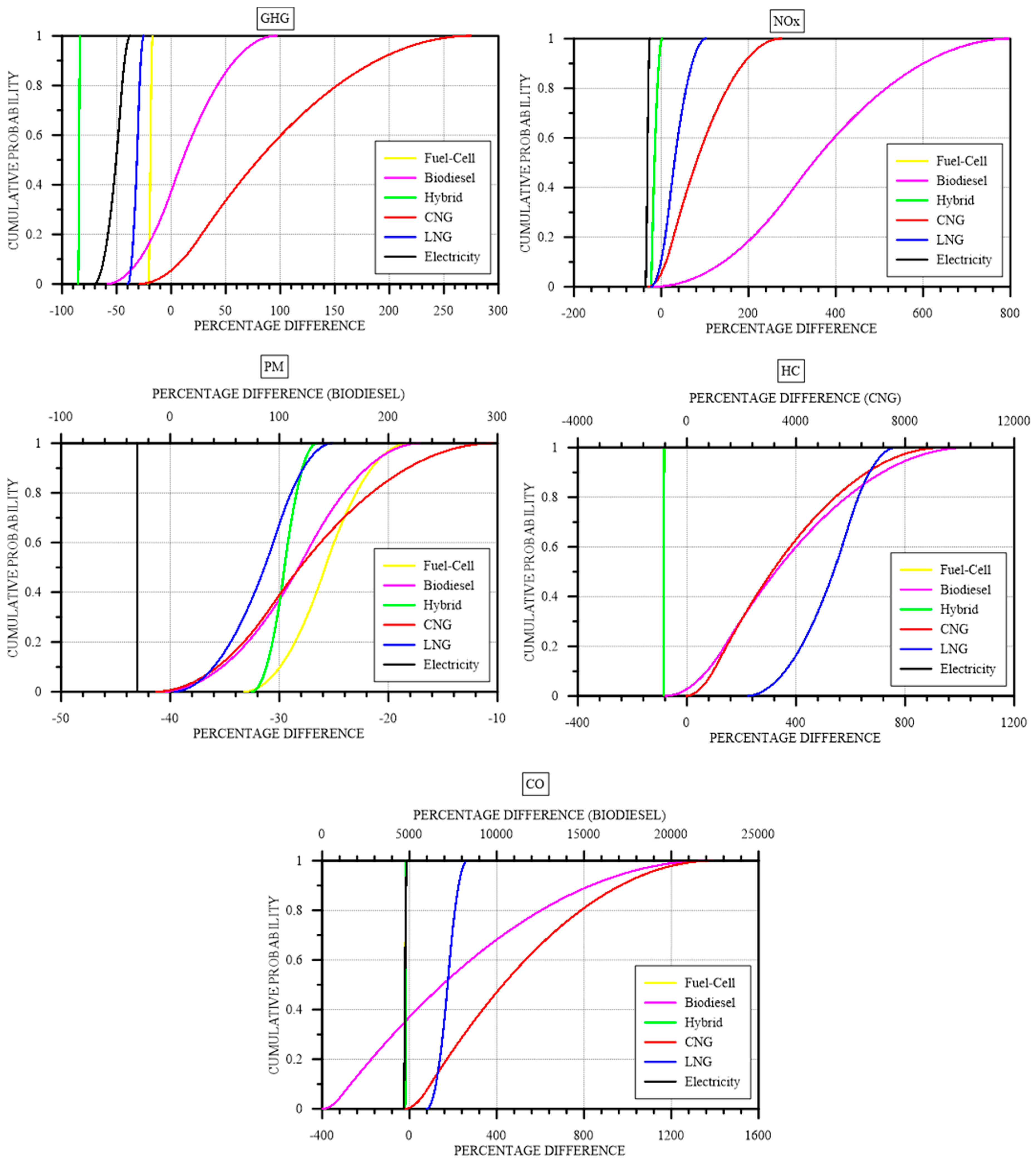
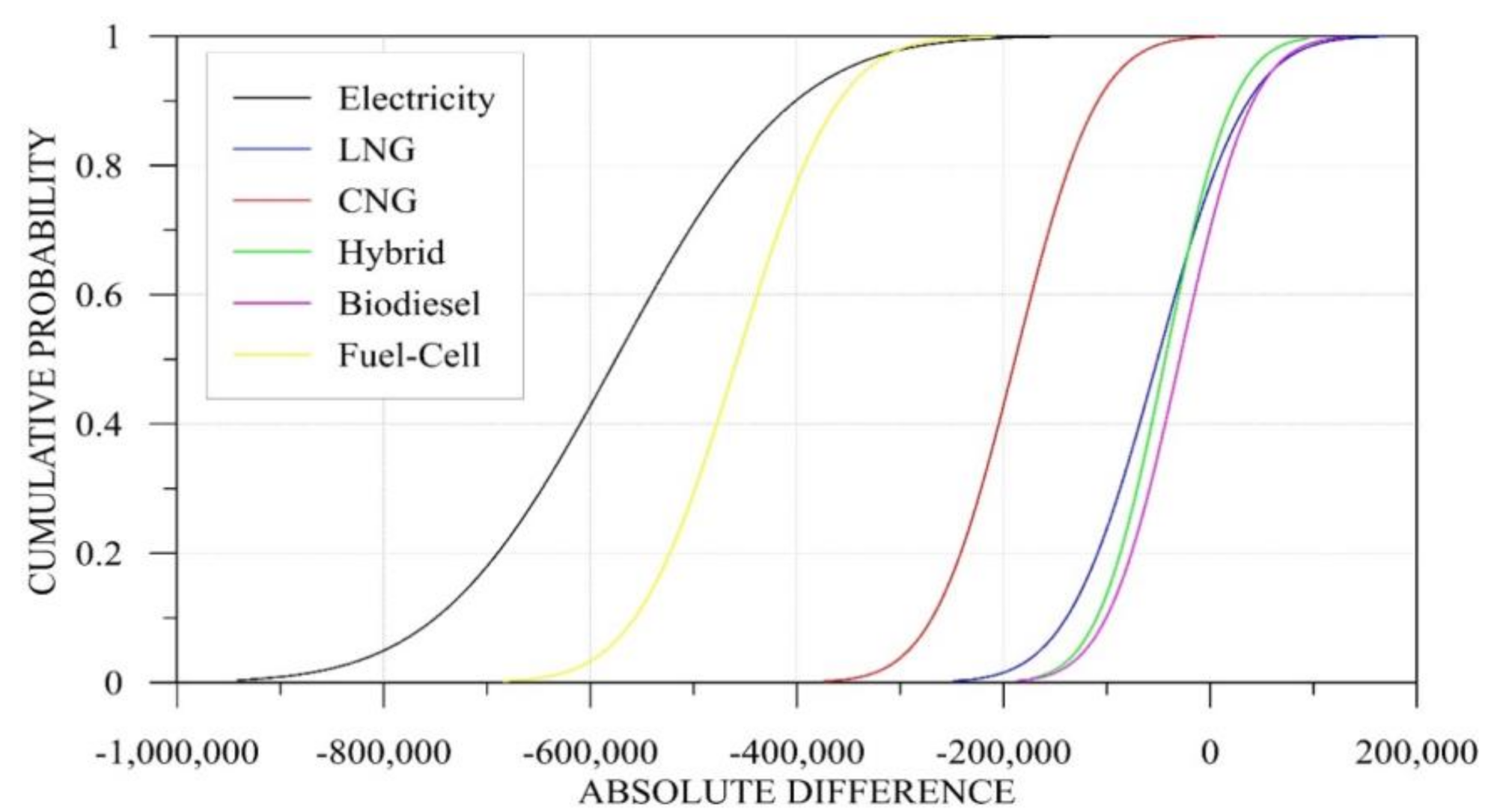
| Demand | ||||||||
|---|---|---|---|---|---|---|---|---|
| Technology | Fuel Consumption (MJ/100 km) | CO2 (g/kWh) | CH4 (g/kWh) | N2O (g/kWh) | NOx (g/kWh) | PM (g/kWh) | HC (g/kWh) | CO (g/kWh) |
| CNG a | 1131.9 | 575.2 | 5.42 | 0.0016 | 2.24 | 0.01 | 0.87 | 1.15 |
| LNG a | 1165.9 | 354.3 | 0.27 | 0.0016 | 1.76 | 0.01 | 0.44 | 2.24 |
| Diesel Hybrid b | 1104.0 | 344 | 0.01 | 0.008 | 0.33 | 0.002 | 0.003 | 0.03 |
| Biodiesel a | 1976.0 | 0 | - | - | 4.11 | 0.04 | 0.05 | 3.4 |
| Fuel-cell electric a | 917.0 | 0 | 0 | 0 | 0 | 0 | 0 | 0 |
| Battery electric a | 456.0 | 0 | 0 | 0 | 0 | 0 | 0 | 0 |
| Transformation | ||||||||
| Technology | CO2e (g/MJ) | NOx (g/MJ) | PM (g/MJ) | HC (g/MJ) | CO (g/MJ) | |||
| Hydrogen (steam methane reform) c | 57 | 0.03 | 0.006 | - | 0.02 | |||
| NG liquefaction d | 8 | - | - | - | - | |||
| Demand | |||||
|---|---|---|---|---|---|
| Vehicles | Stock (Units) | Scrappage (Units) | Sales (Units) | Fuel Consumption (MJ/100 km) | Mileage (Kilometers) |
| Medium and heavy-duty trucks (diesel) a | 412,044 | 16,150 | 45,685 | 1608 | 23,570 |
| Transformation | |||||
| Processing unit | Capacity (MBOE/year) | ||||
| Crude oil refineries b | |||||
| REVAP | 92.73 | ||||
| REPLAN | 152.2 | ||||
| RPBC | 63.8 | ||||
| RECAP | 19.6 | ||||
| NGPU b | |||||
| Caraguatatuba | 51.1 | ||||
| RPBC | 6.4 | ||||
| Biodiesel plants c | |||||
| Bio Petro | 0.2 | ||||
| Biocapital | 0.4 | ||||
| JBS | 0.6 | ||||
| Orlândia | 0.4 | ||||
| SP Bio | 0.2 | ||||
| Electricity generation d | Capacity (MW) | ||||
| Hydropower | 13,290.0 | ||||
| Sugarcane bagasse | 5557.5 | ||||
| Natural gas | 987.8 | ||||
| Other fossil | 1176.8 | ||||
| Other renewable | 47.7 | ||||
| Demand | ||||||||
|---|---|---|---|---|---|---|---|---|
| Vehicles | CO2 | CH4 | N2O | NOx | PM | HC | CO | |
| Medium and heavy-duty trucks (diesel) (g/km) a | 1229.4 | 0.06 | 0.03 | 1.13 | 0.01 | 0.01 | 0.12 | |
| Transformation | ||||||||
| CO2 | CH4 | N2O | CO2e | NOx | PM | HC | CO | |
| Crude oil processing (t/TJ) b | 8 | - | - | - | 0.02 | 0.0035 | - | - |
| NGPU (t/TJ) c | - | - | - | 12 | 0.22 | 0.002 | - | - |
| Biodiesel plant (t/TJ) d | - | - | - | 76 | 0.27 | 0.027 | - | 0.09 |
| Electricity generation (t/TJ) e | ||||||||
| Natural gas | 55.8 | 0.24 | - | - | 1.3 | - | - | 0.34 |
| Diesel | 72.5 | 0.04 | - | - | 1.3 | - | - | 0.35 |
| Residual oil | 76.5 | 0.0009 | 0.0003 | - | 0.2 | - | - | 0.015 |
| Petroleum coke | 76.5 | 0.0009 | 0.0003 | - | 0.2 | - | - | 0.015 |
| Refinery feedstocks | 76.5 | 0.0009 | 0.0004 | - | 0.22 | - | - | 0.016 |
| Sugarcane bagasse | 0 | 0.0003 | 0.004 | - | 0.1 | - | - | 0.1 |
| Wood | 0 | 0.03 | 0.004 | - | 0.1 | - | - | 0.1 |
| R$ (2014)/Vehicle | Battery Electric | Diesel | LNG | CNG | Hybrid | Biodiesel | Fuel-Cell Electric |
|---|---|---|---|---|---|---|---|
| Minimum | 498,946.4 | 139,344.3 | 187,598.0 | 356,088.7 | 277,108.7 | 228,707.8 | 571,719.0 |
| Average | 880,552.3 | 243,077.8 | 319,645.1 | 445,110.9 | 298,834.3 | 285,884.7 | 714,648.7 |
| Maximum | 1,114,503.9 | 386,043.6 | 416,672.9 | 534,133.1 | 324,470.6 | 343,061.6 | 857,578.5 |
| Variable | Premise |
|---|---|
| GDP increase | Based on [49] |
| Demand | |
| Medium and heavy-duty trucks sales a | Elasticity of 1.09 to GDP growth [69] |
| Transformation | |
| NPGU capacity increase b | Addition of 10 × 106 m3/day in 2040, with availability increasing from 54% in 2014 to 100% in 2050. |
| Crude oil refineries capacity increase c | No additional processing increase |
| Biodiesel plants d | Capacity growth of 3.9% per year, with availability increasing from 25% in 2014 to 100% in 2050. |
| Electricity generation e | |
| Natural gas | Capacity growth of 1.5% per year |
| Diesel | Capacity growth of 3% per year |
| Hydropower | Capacity growth of 0.3% per year |
| Solar | Capacity growth of 3% per year |
| Sugarcane bagasse | Capacity growth of 4.7% per year |
| Wood | Capacity growth of 3.3% per year |
| Wind | Capacity growth of 7.6% per year |
| Demand | ||||||||||||||||||||||||||||||
|---|---|---|---|---|---|---|---|---|---|---|---|---|---|---|---|---|---|---|---|---|---|---|---|---|---|---|---|---|---|---|
| Tech. | Fuel Economy (MJ/100 km) | CO2 (g/kWh) | CH4 (g/kWh) | N2O (g/kWh) | NOx (g/kWh) | PM (g/kWh) | HC (g/kWh) | CO (g/kWh) | ||||||||||||||||||||||
| Min | Max | Min | Max | Min | Max | Min | Max | Min | Max | Min | Max | Min | Max | Min | Max | |||||||||||||||
| CNG a | 210 | 2040 | 171 | 1119 | 0.17 | 10.8 | −20% | +20% | 0.01 | 9.08 | 0 | 0.02 | 0.09 | 4 | 0.01 | 9 | ||||||||||||||
| LNG a | 743 | 1394 | 273 | 434 | −20% | +20% | −20% | +20% | 0.03 | 5.04 | 0 | 0.01 | −20% | +20% | −20% | +20% | ||||||||||||||
| Diesel Hybrid a | 909 | 1300 | −20% | +20% | −20% | +20% | −20% | +20% | −20% | +20% | −20% | +20% | −20% | +20% | −20% | +20% | ||||||||||||||
| Biodiesel a | 555 | 3852 | −20% | +20% | −20% | +20% | −20% | +20% | −20% | +20% | −20% | +20% | −20% | +20% | −20% | +20% | ||||||||||||||
| Fuel-cell electric a | 750 | 1025 | - | - | - | - | - | - | - | - | - | - | - | - | - | - | ||||||||||||||
| Electric a | 144 | 936 | - | - | - | - | - | - | - | - | - | - | - | - | - | |||||||||||||||
| Transformation | ||||||||||||||||||||||||||||||
| Tech. | CO2e (g/MJ) | NOx (g/MJ) | PM (g/MJ) | HC (g/MJ) | CO (g/MJ) | |||||||||||||||||||||||||
| Min | Max | Min | Max | Min | Max | Min | Max | Min | Max | |||||||||||||||||||||
| NGPU b | 0 | 33 | −20% | +20% | 0.09 | 0.11 | - | - | - | - | ||||||||||||||||||||
| H2 SMR c | 0 | 59 | 0.02 | 0.05 | 0.005 | 0.008 | - | - | 0.02 | 0.027 | ||||||||||||||||||||
| NG liq. d | 0 | 20 | - | - | - | - | - | - | - | - | ||||||||||||||||||||
| Biodiesel plant e | 0 | 102 | 0.24 | 0.29 | 0.024 | 0.029 | - | - | 0.08 | 0.1 | ||||||||||||||||||||
| Electricity generation | ||||||||||||||||||||||||||||||
| Fossil fuels | 0 | +20% | −20% | +20% | - | - | - | - | −20% | +20% | ||||||||||||||||||||
| Sugarcane bagasse | - | - | −20% | +20% | - | - | - | - | −20% | +20% | ||||||||||||||||||||
Publisher’s Note: MDPI stays neutral with regard to jurisdictional claims in published maps and institutional affiliations. |
© 2020 by the authors. Licensee MDPI, Basel, Switzerland. This article is an open access article distributed under the terms and conditions of the Creative Commons Attribution (CC BY) license (http://creativecommons.org/licenses/by/4.0/).
Share and Cite
Gerber Machado, P.; Rodrigues Teixeira, A.C.; Mendes de Almeida Collaço, F.; Hawkes, A.; Mouette, D. Assessment of Greenhouse Gases and Pollutant Emissions in the Road Freight Transport Sector: A Case Study for São Paulo State, Brazil. Energies 2020, 13, 5433. https://doi.org/10.3390/en13205433
Gerber Machado P, Rodrigues Teixeira AC, Mendes de Almeida Collaço F, Hawkes A, Mouette D. Assessment of Greenhouse Gases and Pollutant Emissions in the Road Freight Transport Sector: A Case Study for São Paulo State, Brazil. Energies. 2020; 13(20):5433. https://doi.org/10.3390/en13205433
Chicago/Turabian StyleGerber Machado, Pedro, Ana Carolina Rodrigues Teixeira, Flavia Mendes de Almeida Collaço, Adam Hawkes, and Dominique Mouette. 2020. "Assessment of Greenhouse Gases and Pollutant Emissions in the Road Freight Transport Sector: A Case Study for São Paulo State, Brazil" Energies 13, no. 20: 5433. https://doi.org/10.3390/en13205433
APA StyleGerber Machado, P., Rodrigues Teixeira, A. C., Mendes de Almeida Collaço, F., Hawkes, A., & Mouette, D. (2020). Assessment of Greenhouse Gases and Pollutant Emissions in the Road Freight Transport Sector: A Case Study for São Paulo State, Brazil. Energies, 13(20), 5433. https://doi.org/10.3390/en13205433







